Giving Context to Cave Art
By Bruno David
Archaeologists bring high-tech tools into the field to analyze prehistoric paintings and find cultural significance that reaches into the present.
Archaeologists bring high-tech tools into the field to analyze prehistoric paintings and find cultural significance that reaches into the present.

In June 2006, Ray Whear sighted the shadow of an unusually large rockshelter during a routine aerial survey of the Arnhem Land Plateau in the far north of Australia. Whear, then the Jawoyn Association Aboriginal Corporation’s Cultural and Environmental Manager, asked pilot Chris Morgan to land the helicopter so they could investigate. Walking a short distance, they found themselves in a stunning gallery with well over 1,000 paintings.
The large, double-ended rockshelter lies on Buyhmi clan lands in Jawoyn Country. The late Bardayal “Lofty” Nadjamerrek, a senior and highly respected Aboriginal “culture man” from Arnhem Land, named the site Nawarla Gabarnmang, which means “place of hole in the rock” in the Jawoyn language. A search for further sites together with detailed study of Nawarla Gabarnmang followed, part of the Jawoyn Association’s aspirations to rediscover and document Jawoyn ancestral places and Jawoyn history at a time of rapid social change. This endeavor was not an abstract exercise, but rather a building of knowledge with community education and the health and promotion of Jawoyn culture and history in mind.
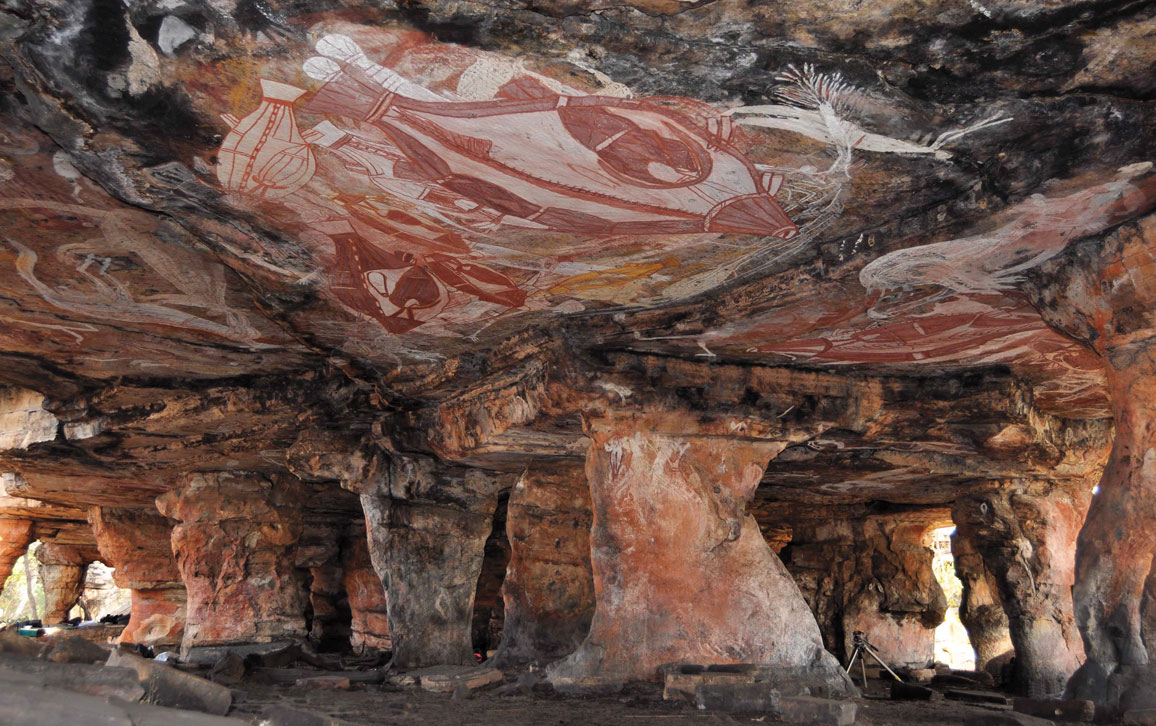
Image courtesy of the author.
What the cave art at a site “means” is informed by the cultural perspectives from which we come. For archaeologists, the process of giving cave art meaning sometimes involves unusual techniques. Finding out how old the art is, how paints were made, or where pigments came from provides necessary context, without which we simply would not know what to make of the art. The science behind the methods that archaeologists use to analyze and date cave art is critical to understanding the reliability of their findings, and shapes how we see cave art today.
There are many ways of recording cave art. Some researchers create lists of common motifs that they then tick off as those motifs are seen at a site. Others draw what they see onto graph paper for reproduction at a proper scale. Most researchers photograph sites extensively, and many then digitally enhance those photos to make the motifs more visible. Some convert their photographs directly into three-dimensional images, for example using photogrammetry on tablets in the field. These methods are not mutually exclusive, with researchers often employing multiple methods to cross-correlate the benefits of each, and for cross-checking. One of the most complex but rewarding ways of documenting a site and its art is by making a high-precision 3D digital model.
Nawarla Gabarnmang is perched near the summit of Australia’s Arnhem Land Plateau. Measuring 32 meters long by 23 meters wide by 2 meters high, the sheltered space is created by more than 50 natural rock pillars supporting a large protective roof over a flat floor. The long, wide ceiling is made up of flat, but staggered, sections of layered rock, offering its artworks and accumulated sediments underneath good protection from the elements. On the ceiling alone, 1,391 paintings and stencils adorn the rock, with hundreds more on the walls of the pillars. The extensively painted pillarscape of Nawarla Gabarnmang makes it one of the most decorated Aboriginal art sites in all of Australia.

Image courtesy of the author.
Recording Nawarla Gabarnmang’s art is no simple task, partly because of its many layers of superimposition, and partly because the site is structurally complex. This complexity has developed over many thousands of years of pillar collapse and roof fall. To properly record and understand the art, we need to understand the evolution of the cave as a structure, and here 3D mapping has been of great service.
Aboriginal people began to occupy the northern and southern entrances of Nawarla Gabarnmang about 50,000 years ago. Sometime after 35,000 years ago—and probably only after 23,000 years ago—people began to knock down pillars to expand the space under shelter. We know this cave modification occurred because in some parts of the site, pillars were left half-broken where people abandoned their activities unfinished. As pillars were removed, individual layers of ceiling rock began to fall down, for they now lacked support.
As the physical shape of the internal structure of Nawarla Gabarnmang changed, so too did the placement of the art on the rock. Broken layers of ceiling rock and pillars left behind fragments of ancient paintings. A small piece of one of these fallen painted ceiling layers dating back to 28,000 years ago has been excavated, proof that paintings were made around that time. We also know that people began painting at Nawarla Gabarnmang tens of thousands of years ago because ocher crayons were recovered from the archaeological excavations, although we do not know what images people then created, nor how much art they made. How, then, are we to make sense of the remnant artworks in this 3D space, a space that can only be properly understood by taking into account a fourth dimension, the evolution of the cave’s material fabric through time?
Three-dimensional laser mapping helped geomorphologist Jean-Jacques Delannoy and digital mapping specialist Benjamin Sadier (both of the Université Savoie Mont Blanc in France) tackle these questions. They began by making a high-definition 3D laser model of the structure of the cave (see below). The art panels could then be individually investigated and interrelated in their proper spatial contexts. Positioning the art in its appropriate location within this pillar landscape is important because Aboriginal people had systematically knocked down pillars and removed layers of rock ceiling at various times in the past, meaning that each extant surface has a different age: Some rock surfaces are many thousands of years old, dating to the last Ice Age, whereas others are much more recent, going back only a few hundred years. Although the age of a rock surface does not tell us the age of the art itself, it does set a maximum age for the paintings on it.

Image courtesy of the author.
Nawarla Gabarnmang cannot simply be conceived of as a natural cave in which people lived and painted, but rather must be viewed as a grand, architectural monument that was also a complex, 3D artistic canvas, one whose shape was altered by people over the course of time. Nawarla Gabarnmang is instructive in showing us that once people enter the scene, they become active agents in constructing their landscapes rather than being passive pawns on an environmental stage. The making of rock canvases upon which to create cave art is one dimension of that active agency, and the general principle of actively inscribing one’s landscape with architectural and artistic designs applies to all peoples of the world, albeit each in different ways.
Cave art researchers are faced with a problem common to all archaeologists: The objects of study begin to break down over time. Issues that particularly affect cave art include granular disintegration of rock surfaces; biological activity such as lichen growth, insect nests, and the rubbing of animals against rock walls; water damage; graffiti; and the accumulation of thin grime and dust mantles that form mineral crusts on walls. The result is a worsening visual appearance of the art through time. These problems are so acute that typically one-tenth to one-half of the paintings in a given site have faded beyond recognition, although the very oldest artworks are often long gone and do not feature in these statistics. But new computer techniques have emerged that enable us to see many of these disappearing artworks.
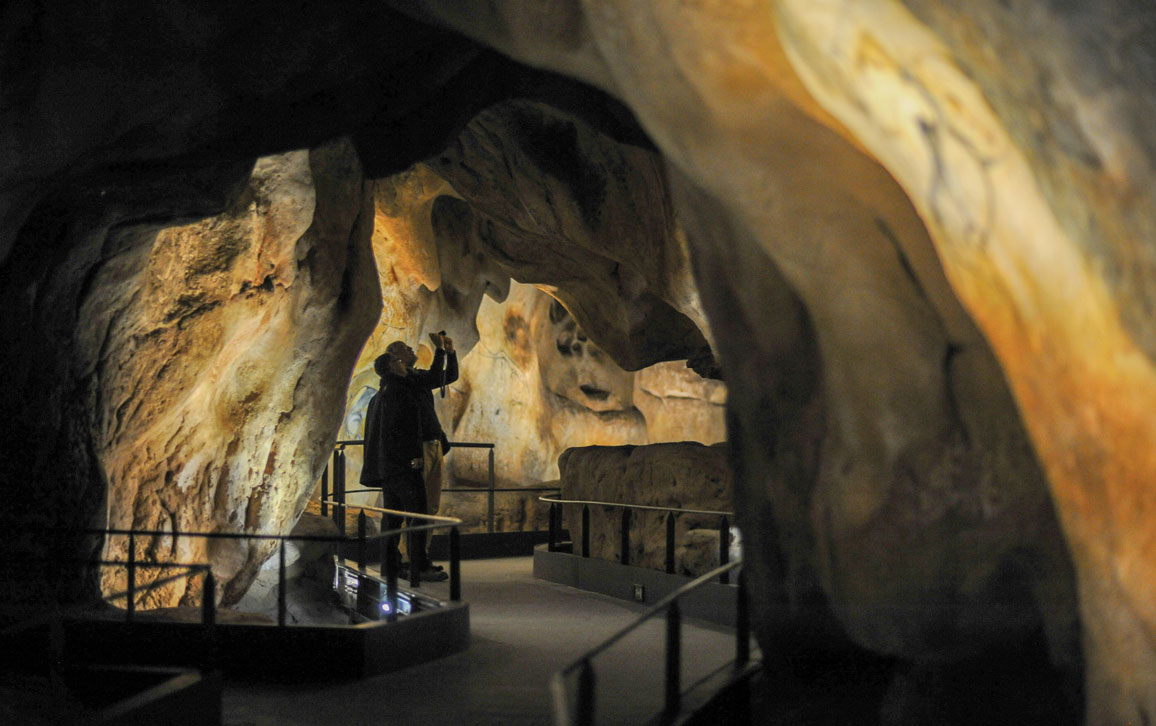
Idealink Photography/Alamy
Digital image enhancement has been around since the 1960s, when it was used to better recognize details in photographs taken by secret spy satellites and space missions. Since the 1980s, computer vision specialists have adapted, further developed, and applied such technologies to the study of rock art around the globe. Now, thanks to commercially available software, digital image enhancement is available to anyone with a computer and a camera.
Over many years, the slow accumulation of dust, the formation of thin, translucent mineral films, or the loss of paint causes cave art to fade. At the same time, the color values move closer to one another and closer to grey, so that differences—contrast—may eventually disappear. The task of the digital enhancer is to manipulate a photograph so as to increase the noticeable difference between the color of the background rock and the color of the rock art. One way of doing this is to increase the distinctiveness of the rock by recoloring the grey or brown pixels (mostly background) of a photograph. Likewise, where there are red paintings, intensifying the reddish color of all pixels will affect the foreground more than the background and bring out the contrast of all colored pixels, and thus the colored regions on the rock surface. Increasing the saturation of colors removes the impact of greys, further increasing the color contrasts.
In 2001 I was part of a team of archaeologists that put these techniques to use on the remote island of Mua in Torres Strait, midway between the northern tip of Australia and the island of New Guinea in the western Pacific Ocean. The local Mualgal Indigenous community at the coastal village of Kubin had asked us to record cultural sites across the island as part of an awareness program aimed at ensuring the education of Mualgal youths on cultural matters relating to their own historical traditions.
Early in the dry season, Mualgal elder John Manas, along with his daughter Louise Manas and community member Guy Neliman, took me and two of my Monash University colleagues, Ian McNiven and Joe Crouch, to a place called Uma, where twin springs flow. Here lay a pile of rocks marking the grave of a man who had been killed in the 1870s by a party of headhunters from the neighboring island of Badu. To this day, the Mualgal continue to commemorate the story of that event, not so much for the death of the man, but for the survival of his young son, Goba, who, according to oral tradition, had hidden up a tree at the urging of his father to escape the warring party.
Some 100 meters from the grave at Uma is a small, low hill, on top of which sits a large granite boulder known as Turao Kula (tura meaning spy, ao denoting the past tense, and kula meaning rock). The boulder served as a natural lookout point onto which Mua Islanders once climbed to survey their surroundings. On the ground under an overhang are many stone artifacts, marine shells, bones, pieces of use-worn ocher, charcoal, and some glass and metal from more recent times. Faint traces of red could be seen on the rock wall, but they were too faded to make out the shapes of the paintings.
We took pictures of the faded rock art with a digital camera and transferred them to our laptop. Then we adjusted the photographs’ brightness and contrast to get the best picture. Next we adjusted the image saturation, intensifying the colors and making them look more distinct. We then adjusted the hue in the image, because the human eye can distinguish some color differences better than others. Next we tried to expand the contrast between the average colors of the different regions of the spectrum. We continued to experiment with these tools until we reached results that produced the best contrast between the background rock and the foreground paintings.
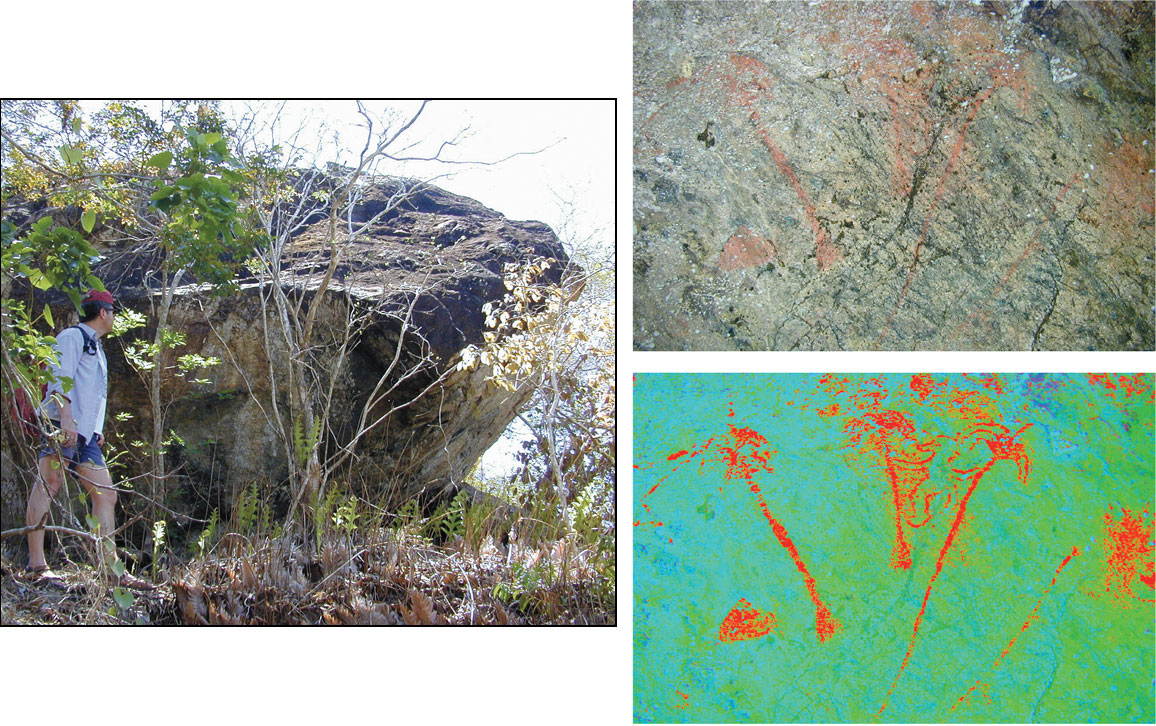
Images courtesy of the author.
On the computer screen, from a mass of gray with faint tinges of red, emerged the clear image of a person climbing a tree, akin to the tale of Goba as retold in oral traditions (see above). Digital enhancement had revealed a painting done long ago about an actual event that to this day is retained in social memory. The following year, the Mualgal community began what would become annual celebrations to remember and honor local culture and history; these are held at Uma and prominently feature the Goba story and the rediscovered paintings on Turao Kula. The newly discovered artworks were not just about the past, but were also about present social concerns for the cultural well-being of an Indigenous island community.
Being able to see cave art is one thing, but finding out how old it is brings an entirely new set of challenges. Accurately assessing the age of cave art requires some knowledge of the science underlying the various available dating techniques.
Let us begin by differentiating between two kinds of chronologies: relative and absolute. Relative dating refers to the ordering of artworks in a temporal sequence, whereas absolute dating obtains actual ages for the art. Various kinds of information can help us understand the relative age of artworks. For example, heavily weathered or exfoliated rock surfaces are usually signs that a long period of time has passed since artworks were created. Evidence that water flow has shifted across a rock surface can tell us that environmental conditions have changed. Alterations to the physical structure of a rock can tell us that enough time has passed for the rock to have witnessed major movements, or that forces such as earthquakes have disrupted the earlier shape of the rock.
The main method of relative dating documents how artworks are layered on top of one another on a rock wall: A painting that has any part of it covered by another means than the underlying one must be older than the one on top. However, we do not know from this information alone how much older the underlying art is. It could have been done immediately before the overlying image during a single artistic event, or it could have been created thousands of years before.
The newly-discovered artworks were not just about the past but also about present concerns for the cultural well-being of an Indigenous island community.
A good example of superimpositions again comes from Nawarla Gabarnmang. Rock art specialist Robert Gunn of Monash University has been studying the rich artworks at the site, photographically recording the rock surfaces and then digitally enhancing the artworks using DStretch. This automated digital enhancement program is specifically designed for rock art, and it enabled Gunn to more clearly distinguish the paintings and the relative order of their superimpositions. Once the individual paintings were identified, the superimposed layers were separated out on the computer. The series of progressively underlying artworks represented increasingly older paintings. With this information, a sequence of changing artistic styles became evident.
The pattern of superimpositions in one panel shows the evolution of so-called x-ray art, which illustrates the skeletal and muscular structures of animals. Archaeologists had long theorized that x-ray art is probably no greater than 3,000 years old across the region, but its real age was not known. At Nawarla Gabarnmang, Gunn worked out that all of the complex x-ray paintings of fish and other fauna lie in the uppermost layers of painted panels, some of which had up to 43 layers of artwork. Complex x-ray art at Nawarla Gabarnmang is therefore relatively recent in the broader artistic sequence, but learning exactly how recent required information relating to the absolute age of the various art layers.
This analysis was done by obtaining absolute ages on art from other layers on the panels, which was not x-ray art. The art above the dated layers would be younger, that underneath older. Five pieces of beeswax that had been pressed onto the rock surface as elements of larger paintings were each carbon dated to the past 400 years. Furthermore, one panel had a large painting of a horse. As horses first arrived in this part of Australia when the explorer Ludwig Leichhardt passed through in 1845, all of the overlying paintings must be younger than this date. Complex x-ray art only occurs above the beeswax layers dated to the past 400 years, and most of it occurs above the layer of the horse. In Nawarla Gabarnmang, therefore, complex x-ray art dates only to the past 400 years, and it may even date to the period after the arrival of Europeans with horses in 1845. By clarifying the pattern of superimpositions through on-site examination and digital enhancement, and then dating individual paintings within that clarified sequence, Gunn was able to work out how the art had changed in relation to the region’s known social history.
Nawarla Gabarnmang is covered in many layers of superimposed paintings, the analysis of which is made more complex by the fact that the artworks are scattered on panels across a very large site with uneven rock surfaces. Gunn employed a useful graphic method known as a Harris Matrix to show the temporal relationship between images in the complex configurations (see below).
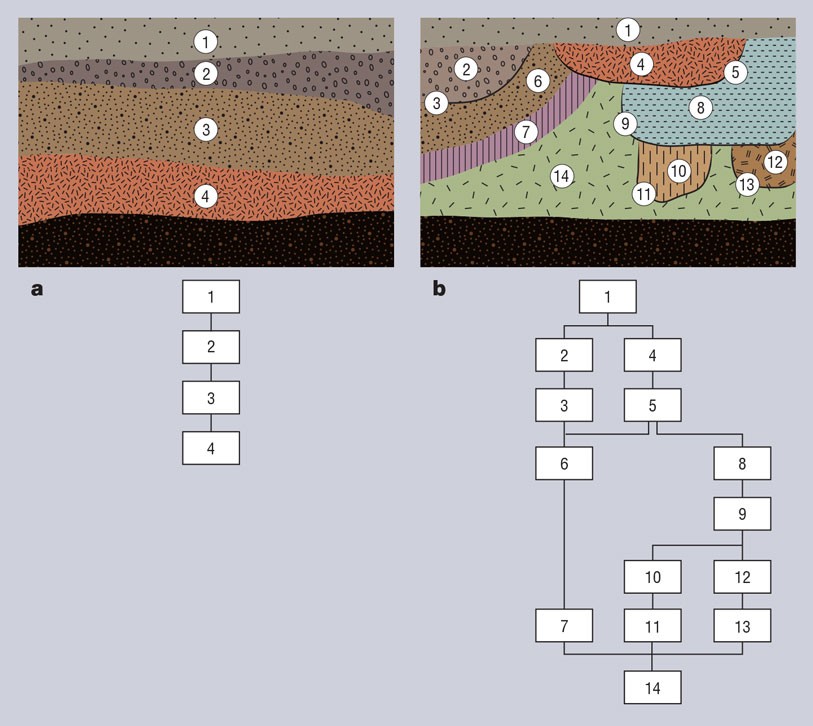
Barbara Aulicino
Harris Matrices were originally designed to track relationships between soil layers in archaeological excavations. We can think of artworks on rock surfaces in the same way as layers of soil underground, albeit at a microscale. At Nawarla Gabarnmang, each panel can contain many dozens of paintings, some of which overlap, some of which do not, but on the whole most or all of the paintings within a given panel touch at least one other painting. That means that a relative temporal sequence of artworks can be worked out for each panel, taking each instance of overlap into account. The overall pattern is too complex to work out by eye, so computerized Harris Matrices are a fundamental tool by which to further explore patterns of superimposition not just within single panels, but across panels as well in ever-expanding spatial scales and increasingly complex networks of spatial data.
Carbon dating is the most commonly used method of absolute dating in cave art research. The basic principle of carbon dating is that radioactive carbon atoms change at a known rate over time. There are three types of carbon atoms in nature: carbon-12, carbon-13, and carbon-14, with the number representing the total number of neutrons and protons in the nucleus of the atom. Atoms in the stratosphere are bombarded by powerful cosmic rays. When this happens, nitrogen-14 atoms—the stable nitrogen isotope and most abundant component of the atmosphere—are transformed into radioactive carbon-14 atoms. Over time, the unstable carbon-14 atoms revert to stable nitrogen-14. Carbon-14 decays at a steady rate, or half-life, meaning that half of the atoms revert to nitrogen-14 approximately every 5,730 (plus or minus 40) years. This rate is critical for our ability to reliably determine the age of cave art by carbon dating.
When an animal or plant is alive, it consumes carbon through nutrients from the environment that include radioactive carbon-14 from the atmosphere. But when the organism dies, the radioactive carbon ceases to be replenished, and thus any carbon-14 in the decaying plant or animal slowly reverts back to nitrogen-14. The amount of carbon-13 and carbon-12 remains the same, as these are not radioactive but stable. Because scientists know how much carbon-12, carbon-13, and carbon-14 there is in nature, and because they know the decay rate of carbon-14, the ratio of the remaining carbon-14 to the other two carbon isotopes effectively becomes a formula for when an organism died. If exactly half the proportion of carbon-14 is found in an animal bone or a piece of charcoal, then we know that the animal or tree died between 5,770 and 5,690 years ago. If only a quarter remains, then the sample would be between 11,540 and 11,380 years old (11,460 plus or minus 80 years), and so forth. Carbon dating only works up to about 55,000 years ago, because by that point the amount of carbon-14 left in a sample is too small to measure reliably.
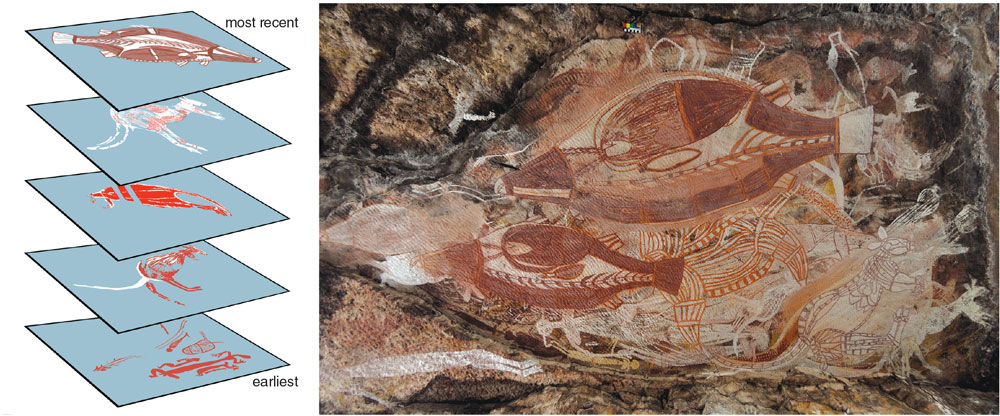
Images courtesy of the author.
Carbon dating is especially useful in cave art research because many artworks contain organic carbon in materials such as charcoal or beeswax that can be reliably dated. Carbon dating gives a time range for when the organic material used to create the art stopped being replenished by new carbon-14. So in reality, although carbon dating gives us an absolute age, the age refers to when the organism that gave the carbon atoms died, rather than when the painting itself was created.
We can usually assume that those two events—the death of the organism and the creation of the artwork—took place at about the same time, within an archaeological timeframe. But caution is needed, as black charcoal drawings, for example, could have been done with old pieces of charcoal that had lain on the ground for long periods of time, which is known as the old charcoal problem. Or, because the trunk and limbs of a tree have their oldest, dead wood nearer their central cores, with the more recent, living wood in their outer layers close to the bark, the burning of very old trees will make the charcoal from the inner wood seem as old as the tree when it began to grow, and the charcoal from the outer wood seem as young as the time of its death: the old wood problem.
Nawarla Gabarnmang is an architectural monument and artistic canvas whose shape was altered by people over time.
In the tropical islands of Vanuatu, archaeologist Meredith Wilson (then at the Australian National University) and her team used carbon dating in a different and rather unusual way to date art on cave walls. In 1996, Wilson was in the midst of conducting a systematic study of the caves of the archipelago. On the island of Malekula, a local chief took her to a site called Hopnarop. There, Wilson set about systematically recording the art. She returned to the site the following year to collect samples of mud-dauber wasp nests that lay sometimes under, sometimes over the art, and tiny scrapings of the black charcoal artworks. Her aim was to determine the age of the samples through carbon dating and thereby study how styles had changed through time since the initial occupation of the island by Lapita settlers close to 3,000 years ago.
During her second trip Wilson rephotographed the art and set about collecting samples, each carefully chosen to date specific motif types from which she could then work out the age and sequence of styles for this site and for the region. Comparing her 1996 photographs with those of 1997, however, she noticed that something had changed: On a wall close to the outer edge of the cave two new, freshly created black hand stencils stood out against the weathered background of the limestone rock. Hopnarop was not simply a cultural site of times past, but a living cultural landscape with which local people continued to engage and to make art. This discovery was an opportunity to test the reliability of carbon dating on cave art with a precisely known age, something that had rarely happened before in rock art research.
Wilson obtained 12 carbon dates from five charcoal hand stencils and from pollen or insects taken from three mud-dauber wasp nests, many of these samples lying in superimposition. Charcoal from the hand stencils created between 1996 and 1997 was divided into two samples, dated twice. They gave near-identical ages. Pollen and an insect in a wasp nest lying immediately under one of the recent stencils were slightly older, consistent with the order of superimposition. Charcoal samples from two other hand stencils located under wasp nests were both slightly older than the nests themselves, again consistent with the pattern of superimpositions.
At Nawarla Gabarnmang and Hopnarop, as with dozens of other sites around the world, archaeologists have successfully determined the ages of paintings and stencils by carbon dating their organic components. These are additive kinds of art, where images are created by adding pigment onto rock walls. But caves often also include engravings, where an image is carved into the rock. How, then, can we obtain absolute ages on images not made by the addition of datable materials, but rather by the removal of parts of the rock surface? For a long time there appeared to be no answer to this dilemma, until in 2000 geochemist Alan Watchman of Flinders University in Australia offered an ingenious solution.
We can think of artworks on rock surfaces in the same way as layers of soil underground, albeit at a microscale.
At the Wardaman Dreaming site of Yiwarlarlay in northern Australia, there are numerous engravings, some made by rubbing the edge of a rock against the soft sandstone wall and thereby making abraded grooves, others made by pounding a rock onto the wall until a depressed shape was formed. Here, a row of kangaroo or wallaby tracks was pounded onto the wall sometime in the past, but the rock surrounding those tracks has remained intact. Across this part of the wall the rock surface has built up microscopic layers of mineral accretions, a cortex skin that covers both the engraved tracks and the untouched rock next to them. That rock skin both within and abutting the kangaroo or wallaby tracks was sampled with a scalpel blade. Watchman then looked at the sample in cross section, literally micro-excavating—sometimes with hand tools and sometimes with a laser—a sequence of laminated microlayers of cemented mineral crust.
Through time, accumulated salts, dust, ash, and organic compounds had repeatedly built up on the rock surface, much like dust builds up on furniture. Buried within those micro-laminae of variably cemented minerals, clear microlayers of white, red, and yellow pigment could be seen in the cross-sections, evidence of ancient paints that are no longer visible on the rock surface. Some of the individual layers contained the calcium oxalate mineral whewellite, a mineral salt of organic origin which contains enough carbon for dating. By dating the carbon trapped in microlayers below and above buried layers of paint, Watchman determined the maximum and minimum ages of those painting events.
As for the engravings, at some time in the past a hammerstone was used to hit through the surface of the rock, thereby creating the animal tracks. The sequence of microlayers of cemented crust showed that the engravings were made by removing a thin layer of silica immediately overlying the bedrock. At the time of their creation, that same layer was partly covered with red paintings. Through time, salts and dust particles accumulated on both the newly created rock surface of the engraved tracks and the surrounding untouched areas.
Carbon extracted from strategically selected micro-laminae of the accumulated rock crust allowed Watchman and his team to determine that the engraved tracks were created roughly 3,400 years ago. By looking at the relationship between the engravings and the microlayers of mineral crust in cross-section—by looking through the rock—Watchman was able to give the approximate age of the engravings. Although other researchers had obtained dates for rock crusts before, Watchman had invented a new method to date rock engravings.
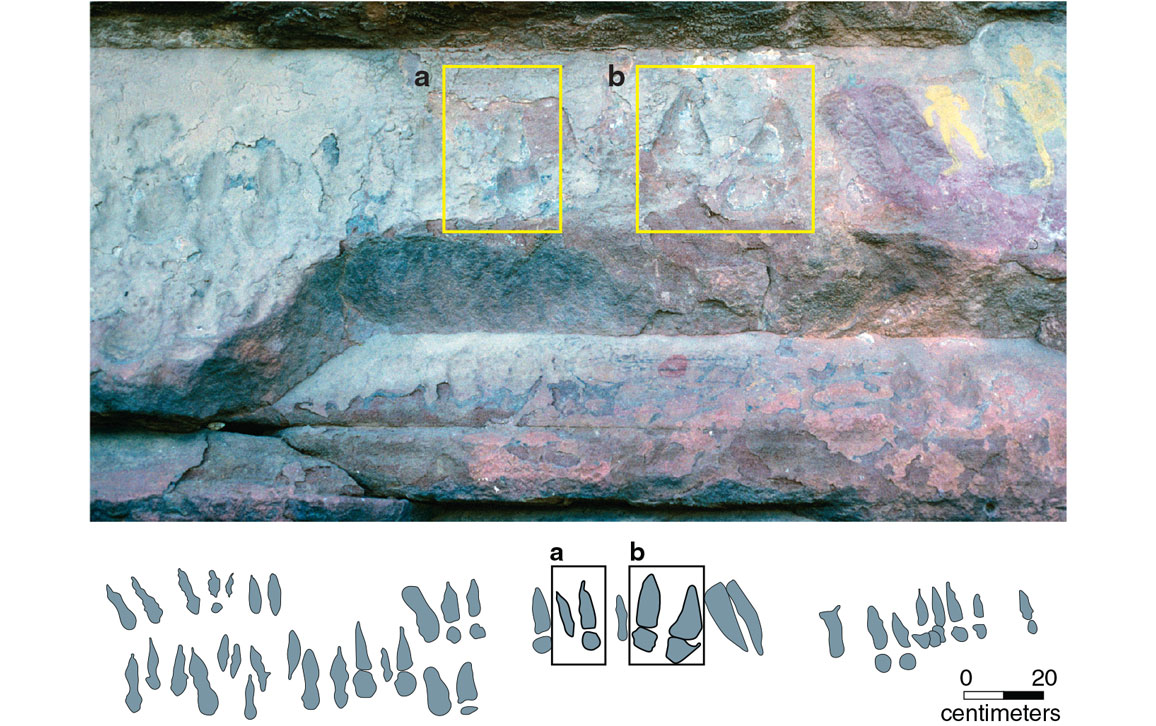
Image courtesy of the author.
The archaeologist’s toolkit includes other methods of absolute dating. One technique, optically stimulated luminescence, can compare the amount of light emitted by grains of quartz to the rate at which radiation is absorbed in the local environment. This information can then be used to determine, for example, when a mud-dauber wasp built its nest on top of a cave painting, thus providing a minimum age for the art underneath. Another method is uranium- series dating, which can be used to date calcium carbonate deposits bracketing paint layers on cave walls. Archaeologists take these data about the age of the cave paintings and compile them with information about the cave environment and the people who lived there to provide context for the art.
We approach a cave not in a detached or unconnected way. Rather, we connect with it; we bring both the site and the art into our lives by how we make them meaningful to ourselves. We explore that meaning by trying to decipher the art: What it looks like, how old it is, and what it means, all of which are dimensions of attachment that begin to take shape as we come to connect. Though a silent reminder of distant peoples or a relic of a long-gone past, cave art continues to speak to us today and to draw our imagination about how we fit into a much grander world.
This article is excerpted and adapted from Cave Art, © 2017 Thames & Hudson Ltd., London. Reprinted with permission from Thames & Hudson, Inc.
Click "American Scientist" to access home page
American Scientist Comments and Discussion
To discuss our articles or comment on them, please share them and tag American Scientist on social media platforms. Here are links to our profiles on Twitter, Facebook, and LinkedIn.
If we re-share your post, we will moderate comments/discussion following our comments policy.